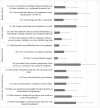Impact of COVID-19 pandemic related stressors on patients with anxiety disorders: A cross-sectional study
- PMID: 35980908
- PMCID: PMC9387803
- DOI: 10.1371/journal.pone.0272215
Impact of COVID-19 pandemic related stressors on patients with anxiety disorders: A cross-sectional study
Abstract
The COVID-19 pandemic and related containment measures are affecting mental health, especially among patients with pre-existing mental disorders. The aim of this study was to investigate the effect of the first wave and its aftermath of the pandemic in Germany (March-July) on psychopathology of patients diagnosed with panic disorder, social anxiety disorder and specific phobia who were on the waiting list or in current treatment at a German university-based outpatient clinic. From 108 patients contacted, forty-nine patients (45.37%) completed a retrospective survey on COVID-19 related stressors, depression, and changes in anxiety symptoms. Patients in the final sample (n = 47) reported a mild depression and significant increase in unspecific anxiety (d = .41), panic symptoms (d = .85) and specific phobia (d = .38), while social anxiety remained unaltered. Pandemic related stressors like job insecurities, familial stress and working in the health sector were significantly associated with more severe depression and increases in anxiety symptoms. High pre-pandemic symptom severity (anxiety/depression) was a risk factor, whereas meaningful work and being divorced/separated were protective factors (explained variance: 46.5% of changes in anxiety and 75.8% in depressive symptoms). In line with diathesis-stress models, patients show a positive association between stressors and symptom load. Health care systems are requested to address the needs of this vulnerable risk group by implementing timely and low-threshold interventions to prevent patients from further deterioration.
Conflict of interest statement
The authors have declared that no competing interests exist.
Figures




Similar articles
-
Investigating the relationship of COVID-19 related stress and media consumption with schizotypy, depression, and anxiety in cross-sectional surveys repeated throughout the pandemic in Germany and the UK.Elife. 2022 Jul 4;11:e75893. doi: 10.7554/eLife.75893. Elife. 2022. PMID: 35781372 Free PMC article.
-
Covid-19-related stressors, mental disorders, depressive and anxiety symptoms: a cross-sectional, nationally-representative, face-to-face survey in Serbia.Epidemiol Psychiatr Sci. 2022 May 24;31:e36. doi: 10.1017/S2045796022000117. Epidemiol Psychiatr Sci. 2022. PMID: 35607805 Free PMC article.
-
Internet-Delivered Cognitive Behavioural Therapy for Major Depression and Anxiety Disorders: A Health Technology Assessment.Ont Health Technol Assess Ser. 2019 Feb 19;19(6):1-199. eCollection 2019. Ont Health Technol Assess Ser. 2019. PMID: 30873251 Free PMC article.
-
The role of pre-pandemic depression for changes in depression, anxiety, and loneliness during the COVID-19 pandemic: Results from a longitudinal probability sample of adults from Germany.Eur Psychiatry. 2022 Nov 3;65(1):e76. doi: 10.1192/j.eurpsy.2022.2339. Eur Psychiatry. 2022. PMID: 36325825 Free PMC article.
-
Global prevalence and burden of depressive and anxiety disorders in 204 countries and territories in 2020 due to the COVID-19 pandemic.Lancet. 2021 Nov 6;398(10312):1700-1712. doi: 10.1016/S0140-6736(21)02143-7. Epub 2021 Oct 8. Lancet. 2021. PMID: 34634250 Free PMC article.
Cited by
-
Evaluation of an Online-Based Self-Help Program for Patients With Panic Disorder: Randomized Controlled Trial.J Med Internet Res. 2025 Apr 2;27:e54062. doi: 10.2196/54062. J Med Internet Res. 2025. PMID: 40173444 Free PMC article. Clinical Trial.
-
Case Report: Neuropsychological Profile of a Patient With Intravascular Large B-Cell Lymphoma Following Infection and Vaccination.Arch Clin Neuropsychol. 2025 Aug 25;40(6):1253-1265. doi: 10.1093/arclin/acaf027. Arch Clin Neuropsychol. 2025. PMID: 40202810 Free PMC article.
-
Health-Promoting Factors and Their Relationships with the Severity of Symptoms in Patients with Anxiety Disorders during the COVID-19 Pandemic.Healthcare (Basel). 2023 Apr 17;11(8):1153. doi: 10.3390/healthcare11081153. Healthcare (Basel). 2023. PMID: 37107986 Free PMC article.
-
The Influence of the COVID-19 Pandemic on Social Anxiety: A Systematic Review.Int J Environ Res Public Health. 2023 Jan 29;20(3):2362. doi: 10.3390/ijerph20032362. Int J Environ Res Public Health. 2023. PMID: 36767728 Free PMC article.
-
Mental health improvement after the COVID-19 pandemic in individuals with psychological distress.Sci Rep. 2024 Mar 7;14(1):5685. doi: 10.1038/s41598-024-55839-3. Sci Rep. 2024. PMID: 38454076 Free PMC article.
References
-
- Wang C, Pan Ri, Wan X, Tan Y, Xu L, Ho CS, et al.. Immediate psychological responses and associated factors during the initial stage of the 2019 coronavirus disease (COVID-19) epidemic among the general population in China. Int J Environ Res Public Health. 2020;17(5). doi: 10.3390/ijerph17051729 - DOI - PMC - PubMed
Publication types
MeSH terms
Supplementary concepts
LinkOut - more resources
Full Text Sources
Medical

